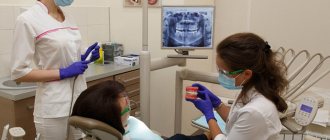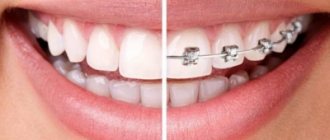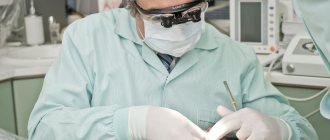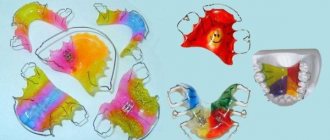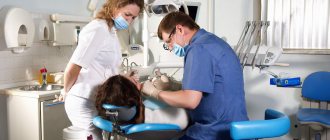Description of structures that can correct the bite
Aligners or mouthguards are structures made of heavy-duty materials.
Advantages of aligners:
- Possibility to remove the structure;
- Made from discreet transparent material;
- Minimal discomfort when wearing;
- There is no need for special care (except for normal hygiene and rinsing with water).
Trainers are structures that are worn for several hours a day, depending on doctor’s orders. They are produced in series, which makes them affordable. Designed to correct minor changes in bite. With their help, it is good to align teeth that are located separately from each other.
Braces are small brackets connected by a power arc. Such designs are capable of correcting a large number of different deviations.
Note: They are worn depending on the initial curvature of the teeth and the body’s adaptation to changes, from two months to five years.
Why is malocclusion dangerous?
An incorrect bite can lead to:
- early tooth decay. As a result of malocclusion, increased stress occurs on individual teeth. Usually the chewing teeth (first molars) are affected, which begin to quickly deteriorate;
- diseases of the gastrointestinal tract. The main function of teeth is to grind food. With an incorrect bite, food is poorly chewed, resulting in problems with its digestion and assimilation;
- respiratory tract diseases. Some types of malocclusion promote mouth breathing. If the teeth of the upper and lower jaws do not meet at all (open bite), air inevitably enters the child's mouth. This leads to hypothermia, drying out and infection of the oropharyngeal mucosa.
- formation of specific facial features. This may be the so-called “ bird face
” - with an unexpressed or sloping chin. Worth mentioning: if an attempt to smile leads to exposure of a significant part of the gum of the upper jaw, a person may begin to feel embarrassed about his ugly smile and stop smiling.
Which doctor puts on braces?
Patients often have a question: what is the name of a braces doctor? Bite anomalies are a field for the work of an orthodontist. Due to the rather narrow specialization of such a specialist, it is not always easy to find him.
The results of correcting the bite primarily depend on who puts the braces on, that is, on the qualifications of the doctor, as well as on the equipment of the dentistry where the treatment is carried out. If the doctor has correctly diagnosed and drawn up the correct correction plan, the patient can already count on successful treatment.
Some people are mistaken in believing that only young patients consult an orthodontist. After all, adults can also get braces. The only thing is that, due to the high density of dental tissue in adults, they will have to wear braces longer than children.
How to choose a doctor and clinic
Before undergoing this dental procedure, you should pay attention to which doctor installs veneers. Not every specialist can provide this service.
A dental clinic must have certificates and licenses that allow it to carry out manipulations of this nature. Also, the staff must officially have a doctor with appropriate qualifications.
Which doctor puts veneers on teeth? This procedure cannot be performed by a general dentist. The specialist may be a dental surgeon or an implantologist, but the doctor must be qualified as an orthopedist.
Clinic “A - Medic” in Moscow is a dental center that has been providing implantology services for several years. We offer installation of high-quality veneers (ceramic, composite, lumineers, etc.) with a service life guarantee.
The clinic often holds promotions and discounts that allow you to get the “smile of your dreams” at an affordable price. On the website you can see prices for services, see photos of our patients before and after the procedure, and also read reviews about the work of specialists and the results of services provided in the clinic.
Features of the orthodontist's work
When seeing a patient, the doctor needs to explain to him the purpose of wearing braces and how this will affect changes in the bite. On average, an orthodontist manages to see up to 13 people in one working day. One appointment takes approximately 30 minutes.
Treatment with braces takes place in 2 stages. At the first stage, the doctor makes a diagnosis and installs correction devices. At the next stage, it is secured by installing mouthguards or retainers on the inside of the teeth, which resist displacement of the bite.
For each situation, the doctor needs to choose the appropriate design. Braces differ in the method of fastening, the principle of influence and appearance.
Types of bites can be different. Let's consider the main ones:
- hereditary, passed on from parents to their children. Bite defects in this case are combined with the presence of additional teeth, diastema and trema. When diagnosing, there is a need for additional procedures;
- congenital, when disorders occurred already during the development of the fetus. Then, after birth and adulthood, dental defects or lack thereof are observed. This complex type of bite is a job for an experienced orthodontist;
- acquired, arising years after birth. It can be recognized at an early stage of its appearance, so treatment is more effective and does not take much time.
Today, an orthodontist in cities can be found in both private and city dentistry. Therefore, people with malocclusion can easily be helped by a qualified doctor who can correct defects and make their smile attractive.
An orthodontist who is popular among patients usually has human qualities in addition to professional ones. He is tolerant, sociable, efficient and friendly. Also, a good orthodontist must be a psychologist in some way. After all, many people have a negative attitude towards braces, the installation of which can cause them stress. A good doctor knows how to win over a client and help him as much as possible.
An orthodontist is not just a dentist, his work is designed to make teeth beautiful, without causing discomfort, and people happy and smiling.
Causes of malocclusion in children
The main reasons contributing to the formation of malocclusion in a child are:
- untimely teething;
- problems with posture;
- Sucking on a pacifier, pacifier, or foreign objects for too long;
- mouth breathing (a consequence of ENT diseases. Normally, the child breathes through the nose, and the mouth should be closed);
- heredity;
- the predominance of soft foods that do not create the necessary load on the jaw apparatus.
When should you see a doctor?
Let's consider the cases in which you need to see an orthodontist:
- If there are defects that spoil the aesthetic condition of the smile, the patient can voluntarily consult a doctor.
- In case of disorders of the dentofacial apparatus (for example, complications after prosthetics or tissue damage), a visit to the orthodontist is simply necessary.
- Formation of a deep bite.
- The lower jaw is positioned incorrectly.
- The presence of negative habits (speech deviations, the patient often sucks his finger, etc.).
- Curled teeth.
- Secondary malocclusion.
The services of an orthodontist can eliminate problems that interfere with prosthetics, or make it possible to avoid them.
An orthodontist also treats caries, periodontitis, periodontal disease and gingivitis.
The main stages of the work of an orthodontist
An examination by a doctor called an orthodontist includes the following steps:
- external examination, which allows you to determine the correct position of the patient’s teeth, jaw and possible deviations from the norm;
- X-ray diagnostics, with the help of which the doctor determines the degree of curvature of the dentition and the need to install braces;
- formation of plaster casts, from which an individual design will be made in the future. This is an important stage that requires increased attention from the doctor. If you make the slightest mistake in the calculations, the installation of braces will be ineffective.
After taking plaster casts, the doctor talks with the patient and determines the material for making braces (metal, ceramics, etc.). Before installing orthodontic systems, it is necessary to familiarize the patient with all the advantages and disadvantages of a particular design.
Stages of treatment by an orthodontist
At the beginning of treatment, the specialist conducts a diagnosis, which largely determines the final result.
The patient goes through the following stages:
- Visual inspection. The doctor studies the symmetry of the face, shape, profile and features of the oral cavity. An assessment is made of the general appearance of the teeth and jaws. The movement of the jaw and the closure of teeth are studied. The examination helps to identify how severely the bite is deformed and determine how difficult and long the treatment will be.
- An oral x-ray gives a general picture of the condition of the jaws and teeth. The image shows features that may not be noticed during normal examination.
- Making plaster models based on dental impressions taken. The model shows the location of the teeth, all the cusps and pits of the jaw. The specialist measures the necessary parameters and determines possible deviations. All features of the planned design must be taken into account at this stage.
Having determined the diagnosis, the specialist decides on a method to correct the problem:
- myotherapy - used only for small patients who are not allowed to have braces. Gymnastics of the jaws is carried out, during which children are given a correct bite that has not had time to form. The method cannot guarantee a 100% result. Gymnastics can also be used for adult patients when there are features that resist the use of other methods;
- hardware - used for patients of any age. For adults, the adjustment will take one to two years longer than for children. The procedure itself takes about an hour. The doctor installs braces, plates or aligners;
- surgical - used when there is no room in the mouth for teeth to grow or they are severely twisted.
Orthodontist: what he does and what he treats
The services of the dental clinic include orthodontic treatment. Orthodontics is a branch of dentistry that studies the causes of dental anomalies, methods for their diagnosis and correction. Dental anomalies are widespread among diseases of the maxillofacial system.
An orthodontist is a doctor who diagnoses and treats dental anomalies in children and adults. This is a narrow dental specialty: the doctor undergoes five years of training at a medical institute, then two years of residency in the specialty “Orthodontics”. This doctor treats adults and children.
Principles of treatment
For adult patients with already permanent teeth, the doctor uses non-removable metal braces, ligature-free and others.
It is much easier for children with baby teeth to correct their bite. It is important to see a doctor as soon as possible. This way the correction will be faster, easier and cheaper.
Diagnostic measures such as X-rays, tomography, orthopantomogram and cephalometric analysis contribute to quality treatment.
Cost of aligners
At the PROPRICUS clinic, the price for teeth straightening without braces in adults is fixed. The price includes diagnostics of the jaw joints, drawing up a treatment plan, taking impressions, making mouth guards and repeated consultations. The patient does not need to worry about additional costs.
The amount depends on the duration of treatment with Invisalign aligners:
- 270,000 rubles
- treatment for up to six months; - 320,000 rubles
– treatment for up to one and a half years; - 370,000 rubles
- treatment for one and a half years.
Make an appointment
When can you do without braces?
If the defect is too pronounced or the permanent teeth have already grown in, then most occlusions are recommended to be corrected with braces. Correcting teeth without braces is suitable if:
- There are one or more slightly crooked teeth.
- An adult's bite needs minor correction.
- A quick effect is required.
- Braces should not be used, for example, if you are allergic to metal.
The use of plates or aligners is possible in childhood, when there are no permanent teeth yet. You shouldn’t search the Internet for magical ways of “how to straighten your teeth without braces at home.” Contact an orthodontist immediately, who will be able to assess the extent of the disorder and choose an effective treatment method.
